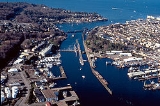
Hiram M. Chittenden Locks
Encyclopedia
The Hiram M. Chittenden Locks are a complex of locks that sit at the west end of Salmon Bay
, part of Seattle
's Lake Washington Ship Canal
. They are known locally as the Ballard
Locks after the neighborhood to their north. (Magnolia
lies to the south.)
The locks and associated facilities serve three purposes:
The complex includes two locks, a small (30 x 150 ft, 8.5 x 45.7 meter) and a large (80 x 825 ft, 24.4 x 251.5 meter). The complex also includes a (235-foot, 71.6 meter) spillway with six (32 x 12 feet (3.7 m), 9.8 x 3.7 meter) gates to assist in water-level control. A fish ladder
is integrated into the locks for migration of anadromous fish, notably salmon
.
The grounds feature a visitors center, as well as the Carl S. English, Jr., Botanical Gardens
.
Operated by the U.S. Army Corps of Engineers, the locks were formally opened on July 4, 1917, although the first ship passed on August 3, 1916. They were named after U.S. Army Major Hiram Martin Chittenden
, the Seattle District Engineer for the Corps of Engineers from April 1906 to September 1908. They were added to the National Register of Historic Places
in 1978.
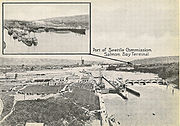 As noted above, the complex includes two locks, a small (30 x 150 ft, 8.5 x 45.7 meter) and a large (80 x 825 ft, 24.4 x 251.5 meter). Using the small lock when boat traffic is low conserves fresh water during summer, when the lakes receive less inflow. Having two locks also allows one of the locks to be drained for maintenance without blocking all boat traffic. The large lock is drained for approximately 2-weeks, usually in November, and the small lock is drained for about the same period. usually in March.
As noted above, the complex includes two locks, a small (30 x 150 ft, 8.5 x 45.7 meter) and a large (80 x 825 ft, 24.4 x 251.5 meter). Using the small lock when boat traffic is low conserves fresh water during summer, when the lakes receive less inflow. Having two locks also allows one of the locks to be drained for maintenance without blocking all boat traffic. The large lock is drained for approximately 2-weeks, usually in November, and the small lock is drained for about the same period. usually in March.
The locks can elevate a 760 feet (231.6 m) by 80 feet (24.4 m) wide vessel 26 feet (7.9 m), from the level of Puget Sound at a very low tide to the level of freshwater Salmon Bay, in 10–15 minutes. The locks handle both pleasure boats and commercial vessels, ranging from kayak
s to fishing boats returning from the Bering Sea
to cargo ships. Over 1 million tons of cargo, fuel, building materials, and seafood products pass through the locks each year.
 Vessels passing from the freshwater lakes (Lakes Washington and Union) to Puget Sound enter the lock chamber through the open upper gates (A in the accompanying diagram). The lower gates (B) and the draining valve (D) are closed. The vessel is assisted by the lockwall attendants who assure it is tied down and ready for the chamber to be drained.
Vessels passing from the freshwater lakes (Lakes Washington and Union) to Puget Sound enter the lock chamber through the open upper gates (A in the accompanying diagram). The lower gates (B) and the draining valve (D) are closed. The vessel is assisted by the lockwall attendants who assure it is tied down and ready for the chamber to be drained.
Next, the upper gates (A) and the filling valve (C) are closed and the draining valve (D) is opened allowing water to drain via gravity out to Puget Sound.
When the water pressure is equal on both sides of the gate, the lower gates (B) are opened, allowing the vessels to leave the lock chamber.
The process is reversed for upstream locking.
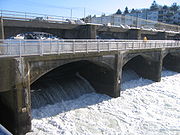 South of the small lock is a spillway dam with tainter gate
South of the small lock is a spillway dam with tainter gate
s used to regulate the freshwater levels of the ship canal and lakes. The gates on the dam release or store water to maintain the lake within a two-foot range of 20 to 22 feet (6.7 m) above sea level. This elevation is necessary for floating bridge
s, mooring facilities, and vessel clearances under bridges.
"Smolt flumes" in the spillway help young salmon to pass safely downstream. Higher water levels are maintained in the summer to accommodate recreation as well as to allow the lakes to act as a water storage basin in anticipation of drought
conditions.
. To prevent this, a basin was dredged just above (east of) the large lock. The heavier salt water settles into the basin and drains through a pipe discharging downstream of the locks area. In 1975, the saltwater drain was modified to divert some salt water from the basin to the fish ladder, where it is added via a diffuser to the fish ladder attraction water; see below.
To further restrict saltwater intrusion, in 1966 a hinged barrier was installed just upstream of the large lock. This hollow metal barrier is filled with air to remain in the upright position, blocking the heavier salt water. When necessary to accommodate deep-draft vessels, the barrier is flooded and sinks to the bottom of the chamber.
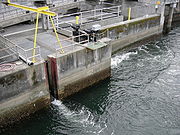

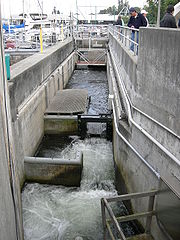 The fish ladder at the Chittenden locks is unusual—materials published by the federal government say "unique"—in being located where salt and fresh water meet. Normally, fish ladders are located entirely within fresh water.
The fish ladder at the Chittenden locks is unusual—materials published by the federal government say "unique"—in being located where salt and fresh water meet. Normally, fish ladders are located entirely within fresh water.
When the Corps of Engineers first built the locks and dam, they changed the natural drainage route of Lake Washington. The locks and dam blocked all salmon runs out of the Cedar River
watershed. (Pacific salmon are anadromous: they hatch in lakes, rivers, and streams—or, nowadays fish hatcheries
—migrate to sea, and only at the end of their life return to fresh water to spawn.) To correct this problem, the Corps built a fish ladder as the locks were constructed to allow salmon to pass around the locks and dam.
The ladder was designed to use attraction water: fresh water flowing swiftly out the bottom of the fish ladder, in the direction opposite which anadromous fish migrate at the end of their lives. However, the attraction water from this first ladder was not effective. Instead, most salmon used the locks. This made them an easy target for predators; also, many were injured by hitting the walls and gates of the locks, or by hitting boat propellers.
The Corps rebuilt the fish ladder in 1976 by increasing the flow of attraction water and adding more weir
s: most weirs are now one foot higher than the previous one. The old fish ladder had only 10 "steps"; the new one has 21. A diffuser well mixes salt water in gradually through the last 10 weirs. As a part of the rebuilding, the Corps also added an underground chamber with a viewing gallery.
The fish approaching the ladder smell the attraction water, recognizing the scent of Lake Washington and its tributaries. They enter the ladder, and either jump over each of the 21 weirs or swim though tunnel-like openings. They exit the ladder into the fresh water of Salmon Bay. They continue following the waterway to the lake, river, or stream where they were born. Once there, the females lay eggs, which the males fertilize. Most salmon die shortly after spawning.
The offspring remain in the fresh water until they are ready to return to the ocean as smolt
s. In a few years, the surviving adults return, climb the fish ladder, and reach their spawning ground to continue the life cycle. Of the millions of young fish born, only a relative few survive to adulthood. Causes of death include natural predators, commercial and sport fishing, disease, low stream flows, poor water quality, flooding, and concentrated developments along streams and lakes.
Visitors to the locks can observe the salmons' progress through windows along their route. Although the viewing area is open year-round, the "peak" viewing time is during spawning season, from about the beginning of July through mid-August. A public art work, commissioned by the Seattle Arts Commission, provides literary interpretation of the experience through recordings of Seattle poet Judith Roche's "Salmon Suite," a sequence of five poems tied to the annual migratory sequence of the fish.

Seattle salmon run viewing schedule at the Seattle Fish Ladder.
Sockeye – June, July; Chinook and Coho – Sept, Oct; Steelhead – late fall and winter
Salmon Bay
Salmon Bay is that part of the Lake Washington Ship Canal--which passes through the city of Seattle, linking Lake Washington to Puget Sound--that lies west of the Fremont Cut. It is the westernmost section of the canal, and empties into Shilshole Bay, which is part of Puget Sound. Because of the...
, part of Seattle
Seattle, Washington
Seattle is the county seat of King County, Washington. With 608,660 residents as of the 2010 Census, Seattle is the largest city in the Northwestern United States. The Seattle metropolitan area of about 3.4 million inhabitants is the 15th largest metropolitan area in the country...
's Lake Washington Ship Canal
Lake Washington Ship Canal
The Lake Washington Ship Canal, which runs through the City of Seattle, Washington, connects the fresh water body of Lake Washington with the salt water inland sea of Puget Sound. The Ship Canal includes a series of locks, modeled after the Panama Canal, to accommodate the different water levels...
. They are known locally as the Ballard
Ballard, Seattle, Washington
Ballard is a neighborhood located in the northwestern part of Seattle, Washington. To the north it is bounded by Crown Hill, ; to the east by Greenwood, Phinney Ridge and Fremont ; to the south by the Lake Washington Ship Canal; and to the west by Puget Sound’s Shilshole Bay. The neighborhood’s...
Locks after the neighborhood to their north. (Magnolia
Magnolia, Seattle, Washington
Magnolia is the second largest neighborhood of Seattle, Washington by area. It occupies a hilly peninsula northwest of downtown. Magnolia is isolated from the rest of Seattle, connected by road to the rest of the city by only three bridges over the tracks of the BNSF Railway: W. Emerson Place in...
lies to the south.)
The locks and associated facilities serve three purposes:
- To maintain the water level of the fresh water Lake WashingtonLake WashingtonLake Washington is a large freshwater lake adjacent to the city of Seattle. It is the largest lake in King County and the second largest in the state of Washington, after Lake Chelan. It is bordered by the cities of Seattle on the west, Bellevue and Kirkland on the east, Renton on the south and...
and Lake UnionLake UnionLake Union is a freshwater lake entirely within the Seattle, Washington city limits.-Origins:A glacial lake, its basin was dug 12,000 years ago by the Vashon glacier, which also created Lake Washington and Seattle's Green, Bitter, and Haller Lakes.-Name:...
at 20–22 feet above sea levelSea levelMean sea level is a measure of the average height of the ocean's surface ; used as a standard in reckoning land elevation...
(Puget SoundPuget SoundPuget Sound is a sound in the U.S. state of Washington. It is a complex estuarine system of interconnected marine waterways and basins, with one major and one minor connection to the Strait of Juan de Fuca and the Pacific Ocean — Admiralty Inlet being the major connection and...
's mean low tideTideTides are the rise and fall of sea levels caused by the combined effects of the gravitational forces exerted by the moon and the sun and the rotation of the Earth....
). - To prevent the mixing of sea water from Puget Sound with the fresh waterFresh WaterFresh Water is the debut album by Australian rock and blues singer Alison McCallum, released in 1972. Rare for an Australian artist at the time, it came in a gatefold sleeve...
of the lakes (saltwater intrusionSaltwater intrusionSaltwater intrusion is the movement of saline water into freshwater aquifers. Most often, it is caused by ground-water pumping from coastal wells, or from construction of navigation channels or oil field canals. The channels and canals provide conduits for salt water to be brought into fresh...
). - To move boats from the water level of the lakes to the water level of Puget Sound, and vice versa.
The complex includes two locks, a small (30 x 150 ft, 8.5 x 45.7 meter) and a large (80 x 825 ft, 24.4 x 251.5 meter). The complex also includes a (235-foot, 71.6 meter) spillway with six (32 x 12 feet (3.7 m), 9.8 x 3.7 meter) gates to assist in water-level control. A fish ladder
Fish ladder
A fish ladder, also known as a fishway, fish pass or fish steps, is a structure on or around artificial barriers to facilitate diadromous fishes' natural migration. Most fishways enable fish to pass around the barriers by swimming and leaping up a series of relatively low steps into the waters on...
is integrated into the locks for migration of anadromous fish, notably salmon
Salmon
Salmon is the common name for several species of fish in the family Salmonidae. Several other fish in the same family are called trout; the difference is often said to be that salmon migrate and trout are resident, but this distinction does not strictly hold true...
.
The grounds feature a visitors center, as well as the Carl S. English, Jr., Botanical Gardens
Carl S. English, Jr., Botanical Gardens
The Carl S. English, Jr., Botanical Garden are botanical gardens located on the grounds of the Hiram M. Chittenden Locks at 3015 NW 54th Street, Seattle, Washington. They are open daily 7 a.m. to 9 p.m...
.
Operated by the U.S. Army Corps of Engineers, the locks were formally opened on July 4, 1917, although the first ship passed on August 3, 1916. They were named after U.S. Army Major Hiram Martin Chittenden
Hiram M. Chittenden
Hiram Martin Chittenden was the Seattle district engineer for the Army Corps of Engineers for whom the Hiram M. Chittenden Locks in Seattle, Washington, were named.-Early Life:...
, the Seattle District Engineer for the Corps of Engineers from April 1906 to September 1908. They were added to the National Register of Historic Places
National Register of Historic Places
The National Register of Historic Places is the United States government's official list of districts, sites, buildings, structures, and objects deemed worthy of preservation...
in 1978.
The locks proper

The locks can elevate a 760 feet (231.6 m) by 80 feet (24.4 m) wide vessel 26 feet (7.9 m), from the level of Puget Sound at a very low tide to the level of freshwater Salmon Bay, in 10–15 minutes. The locks handle both pleasure boats and commercial vessels, ranging from kayak
Kayak
A kayak is a small, relatively narrow, human-powered boat primarily designed to be manually propelled by means of a double blade paddle.The traditional kayak has a covered deck and one or more cockpits, each seating one paddler...
s to fishing boats returning from the Bering Sea
Bering Sea
The Bering Sea is a marginal sea of the Pacific Ocean. It comprises a deep water basin, which then rises through a narrow slope into the shallower water above the continental shelves....
to cargo ships. Over 1 million tons of cargo, fuel, building materials, and seafood products pass through the locks each year.
How the locks work

Next, the upper gates (A) and the filling valve (C) are closed and the draining valve (D) is opened allowing water to drain via gravity out to Puget Sound.
When the water pressure is equal on both sides of the gate, the lower gates (B) are opened, allowing the vessels to leave the lock chamber.
The process is reversed for upstream locking.
Spillway

Tainter gate
The Tainter gate is a type of radial arm floodgate used in dams and canal locks to control water flow. It is named for Wisconsin structural engineer Jeremiah Burnham Tainter....
s used to regulate the freshwater levels of the ship canal and lakes. The gates on the dam release or store water to maintain the lake within a two-foot range of 20 to 22 feet (6.7 m) above sea level. This elevation is necessary for floating bridge
Pontoon bridge
A pontoon bridge or floating bridge is a bridge that floats on water and in which barge- or boat-like pontoons support the bridge deck and its dynamic loads. While pontoon bridges are usually temporary structures, some are used for long periods of time...
s, mooring facilities, and vessel clearances under bridges.
"Smolt flumes" in the spillway help young salmon to pass safely downstream. Higher water levels are maintained in the summer to accommodate recreation as well as to allow the lakes to act as a water storage basin in anticipation of drought
Drought
A drought is an extended period of months or years when a region notes a deficiency in its water supply. Generally, this occurs when a region receives consistently below average precipitation. It can have a substantial impact on the ecosystem and agriculture of the affected region...
conditions.
Salt water barrier
If excessive salt water were allowed to migrate into Salmon Bay, the salt could eventually damage the freshwater ecosystemEcosystem
An ecosystem is a biological environment consisting of all the organisms living in a particular area, as well as all the nonliving , physical components of the environment with which the organisms interact, such as air, soil, water and sunlight....
. To prevent this, a basin was dredged just above (east of) the large lock. The heavier salt water settles into the basin and drains through a pipe discharging downstream of the locks area. In 1975, the saltwater drain was modified to divert some salt water from the basin to the fish ladder, where it is added via a diffuser to the fish ladder attraction water; see below.
To further restrict saltwater intrusion, in 1966 a hinged barrier was installed just upstream of the large lock. This hollow metal barrier is filled with air to remain in the upright position, blocking the heavier salt water. When necessary to accommodate deep-draft vessels, the barrier is flooded and sinks to the bottom of the chamber.
Fish ladder



When the Corps of Engineers first built the locks and dam, they changed the natural drainage route of Lake Washington. The locks and dam blocked all salmon runs out of the Cedar River
Cedar River (Washington)
The Cedar River is a river in the U.S. state of Washington. About long, it originates in the Cascade Range and flows generally west and northwest, emptying into the southern end of Lake Washington...
watershed. (Pacific salmon are anadromous: they hatch in lakes, rivers, and streams—or, nowadays fish hatcheries
Fish hatchery
A fish hatchery is a "place for artificial breeding, hatching and rearing through the early life stages of animals, finfish and shellfish in particular". Hatcheries produce larval and juvenile fish primarily to support the aquaculture industry where they are transferred to on-growing systems...
—migrate to sea, and only at the end of their life return to fresh water to spawn.) To correct this problem, the Corps built a fish ladder as the locks were constructed to allow salmon to pass around the locks and dam.
The ladder was designed to use attraction water: fresh water flowing swiftly out the bottom of the fish ladder, in the direction opposite which anadromous fish migrate at the end of their lives. However, the attraction water from this first ladder was not effective. Instead, most salmon used the locks. This made them an easy target for predators; also, many were injured by hitting the walls and gates of the locks, or by hitting boat propellers.
The Corps rebuilt the fish ladder in 1976 by increasing the flow of attraction water and adding more weir
Weir
A weir is a small overflow dam used to alter the flow characteristics of a river or stream. In most cases weirs take the form of a barrier across the river that causes water to pool behind the structure , but allows water to flow over the top...
s: most weirs are now one foot higher than the previous one. The old fish ladder had only 10 "steps"; the new one has 21. A diffuser well mixes salt water in gradually through the last 10 weirs. As a part of the rebuilding, the Corps also added an underground chamber with a viewing gallery.
The fish approaching the ladder smell the attraction water, recognizing the scent of Lake Washington and its tributaries. They enter the ladder, and either jump over each of the 21 weirs or swim though tunnel-like openings. They exit the ladder into the fresh water of Salmon Bay. They continue following the waterway to the lake, river, or stream where they were born. Once there, the females lay eggs, which the males fertilize. Most salmon die shortly after spawning.
The offspring remain in the fresh water until they are ready to return to the ocean as smolt
Smolt
Smolt may refer to:* Spawn , a juvenile fish.* Smolt , a project aimed at hardware information collection....
s. In a few years, the surviving adults return, climb the fish ladder, and reach their spawning ground to continue the life cycle. Of the millions of young fish born, only a relative few survive to adulthood. Causes of death include natural predators, commercial and sport fishing, disease, low stream flows, poor water quality, flooding, and concentrated developments along streams and lakes.
Visitors to the locks can observe the salmons' progress through windows along their route. Although the viewing area is open year-round, the "peak" viewing time is during spawning season, from about the beginning of July through mid-August. A public art work, commissioned by the Seattle Arts Commission, provides literary interpretation of the experience through recordings of Seattle poet Judith Roche's "Salmon Suite," a sequence of five poems tied to the annual migratory sequence of the fish.

Gallery: Migratory fish
Among the species of salmon migrating routinely through the ladder at the Chittenden Locks are Chinook (king) Salmon (Oncorhynchus tshawytscha), Coho (silver) Salmon (Oncorhynchus kisutch), Sockeye (red) Salmon (Oncorhynchus nerka), and Steelhead (Oncorhynchus mykiss).Seattle salmon run viewing schedule at the Seattle Fish Ladder.
Sockeye – June, July; Chinook and Coho – Sept, Oct; Steelhead – late fall and winter
External links
- U.S. Army Corps of Engineers, Seattle District: Lake Washington Ship Canal and Hiram M. Chittenden Locks
- Chittenden Locks on SeattleWiki
- Virtual tour of Chittenden (Ballard) Locks on vrseattle.com: several 360° photographic panoramas of the locks.

